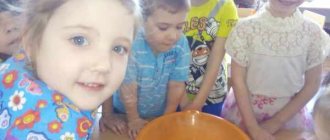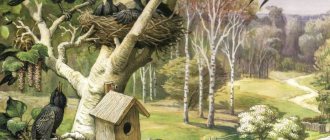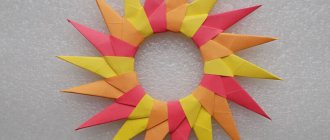Project “Spring is knocking on our windows”
4. “Let’s go swimming in the puddle.” Make boats at home or on a walk, and then launch them in the nearest puddle.
5. “Let’s let the bubbles… float!” You can let not only boats sail through puddles, but also soap bubbles. They will last longer on the water and shimmer with all the colors. Watching such swimmers is a real pleasure.
6. “Looking for the first signs of spring.” Arm yourself with a camera and go in search of spring. The first swollen buds, lively birds - all these are the first signs that spring is coming.
7. “Drawing on the asphalt.” If the asphalt is dry, it's time to take out the crayons and draw an invitation to spring: sun, flowers and grass. Perhaps this will speed up the arrival of heat!
8. “Hunt for words and letters.” If the child knows the letters, you can play a game where the child and the adult look around for objects that begin with the selected letter. You can choose different letters. For example, you are looking for words starting with the letter “a”, and the child is looking for words starting with the letter “m”. Who will find the most items?
9. “Developing speed and coordination.” This game is very famous. The rules are simple: children stand between the two leaders, their goal is to knock the players out of the center with the ball. It is best to take an inflatable ball so as not to injure children. Take a larger ball, then the task for the kids will become much more difficult, and the risk of injury will decrease.
10. “Developing coordination.” Participants stand opposite the leader. The game is very simple. All children must show movements opposite to those shown by the leader. For example, if the leader lowers his hands, the kids should raise them, if the leader crouches, the children should jump, etc. If the kid makes a mistake three times, he is eliminated. The winner is the one who can survive the longest.
11. “Developing balance.” For this exercise, you need to place two children opposite each other at a distance of 2-3 child steps. At the signal, one, standing on one leg, with his palms outstretched, should hit the palms of the other baby. The essence of the game is to unbalance your opponent. The one who touches the ground first loses.
12. “Developing speed of movement.” For this game you need a ball and chalk. On the asphalt, draw a circle with a diameter of about 2 meters and indicate the directions of movement. The child stands in the center and hits the ball on the ground, after which he runs away in the given direction. While the ball makes 3 hits, the baby must run. The one who runs farthest wins. This game is group, but can also be played alone.
13. “Developing jumping ability.” This game requires several players; you should divide them into teams. A line is drawn on the ground with which the length of the jump will be measured. The landing site should be marked on the heels. You need to jump in the opposite direction from the marked place; another participant must do this. His main task is to jump over this result and jump further, thereby earning a point for his team. The team with the most points wins.
Cognitive development project on the theme “Spring is red”
Passport of the project “Spring is Red”
Project type: educational and creative.
Project duration: medium term.
Implementation period: from April 15 to April 29.
Participants: children, parents, teachers, music director.
Children's age: 3-4 years.
Relevance.
From the moment a child is born, he or she is surrounded by the natural world. The child rejoices seeing green grass and flowers, listening to the chirping of birds. First impressions are unexpected and important for a child. Everything new arouses his interest and delight. He wants to try, touch, feel, hear, see. The task of educators and parents is to form correct ideas about the world around them. It is necessary not only to show children what a wonderful world surrounds them, but also to explain why they need to love and take care of nature.
Problem.
In the modern world, children and parents spend even their weekends not in nature, admiring its beauty, observing the changes taking place, enriching and complementing its beauty with their care, but in front of the TV or computer. In this regard, children have not been brought up with a caring attitude towards the awakening nature. Children have no idea about the first flowers of spring. Children have a little knowledge about migratory birds and their life in the spring. Children do not know how to establish the simplest connections between the conditions of the coming external season and the behavior of animals, birds, and the state of vegetation. The level of speech development is reduced, the active and passive vocabulary is small, knowledge about spring changes in living and non-living nature has not been formed. To eliminate this problem, we decided to develop a project on the theme: “Spring is red.”
Objective of the project.
Formation of initial ecological ideas in children.
Objectives of the priority educational area.
— To form children’s ideas about the signs of spring (the state of the weather, sky, vegetation, characteristic precipitation).
— Introduce children to the seasonal changes of plants in the spring.
-Introduce the peculiarities of life of wild animals and birds during the onset of spring.
-Teach to establish the simplest connections between the conditions of the coming spring season and the behavior of animals and the state of vegetation.
Objectives of OO in integration:
Speech development.
Expand and activate children's vocabulary. Develop the ability to select adjectives for nouns. Develop a dialogical form of speech, involve children in conversation while looking at pictures; develop the ability to conduct a dialogue with the teacher; listen and understand the question asked, answer it clearly; learn to recite short poems by heart.
Social and communicative development.
Develop the desire to improvise on simple song plots; consolidate skills of organized behavior in kindergarten; develop a friendly attitude towards each other; develop the ability to work in a team. Learn to follow the rules of behavior in nature.
Artistic and aesthetic creativity.
To develop the ability to convey the beauty of the surrounding nature in a drawing; pay attention to the selection of a color that matches the depicted object. Learn to convey color and shape of leaves, flowers, and trees in modeling, drawings, and appliqués.
Physical development.
Develop all types of motor skills: general, fine, articulatory; develop the ability to coordinate speech with movements. Develop a sense of rhythm. Form an idea of a healthy lifestyle - wash your hands before eating.
Targets.
Educational field "Cognitive development"
— the child shows interest in animals and plants of the immediate natural environment;
- the child is capable of purposeful observation of objects in the natural environment;
- the child is able to distinguish objects and phenomena of the surrounding nature by their characteristics.
- shows interest in the natural world around him, participates with interest in hay observations.
- is able to establish the simplest connections between objects and phenomena, and make the simplest generalizations.
Educational field "Speech development"
- the child enjoys communicating with adults: understands speech addressed to him, answers questions using simple common sentences.
- the child, together with an adult, willingly retells familiar fairy tales, poems, plays with sounds, rhymes, and words;
- the child is proactive in conversation, answers questions, and asks counter questions.
- the child has a fairly good command of oral speech, can express his thoughts and desires, use speech to express his thoughts, feelings and desires, construct a speech statement in a communication situation.
Educational field "Social and communicative development"
- the child willingly enters into role-playing dialogue with peers and adults;
- the child shows interest in playful communication;
- the child willingly participates in joint work with adults or peers, strives to fulfill work duties.
- the child treats the objective world with care as the result of an adult’s labor.
- the child is active in games, the themes reflect family and simple professional relationships between adults.
Educational field "Artistic - aesthetic development"
- the child depicts individual objects, simple in composition and simple in content;
- selects colors that match the depicted objects;
-uses pencils, brushes and paints correctly;
- sculpts various objects consisting of 1-3 parts, using a variety of sculpting techniques;
- listens to musical pieces to the end;
-recognizes familiar songs;
-notices changes in sound (quiet - loud).
Educational field "Physical development"
- the child shows initiative in communicating with other children and adults while participating in outdoor games;
- the child shows interest in the rules of health-saving and safe behavior;
- the child shows elementary creativity in motor activity (modifies physical and sports exercises, creates combinations of familiar exercises, expressively conveys images of characters in folk outdoor games).
Material and technical support.
Audio recordings : “Voices of Nature”, “Birdsong”, “The Sound of the Forest”; selection of artistic, illustrative, gaming material, card index of didactic and outdoor games; role-playing games.
Products of project activities.
- Collective work “Birch tree in spring”
- Exhibition of drawings (children and parents) “Spring Fantasy”
- Vegetable garden on the window (planting onions).
Project implementation stages.
Preparatory stage.
-Definition of the goals and objectives of the project;
-Drawing up a project implementation plan;
-Selection of artistic and musical works on the theme “Spring”
-Selection of didactic material, visual aids (albums for viewing, paintings, board games)
-Development of GCD notes on the planned topic.
Practical stage.
| Activities | Events |
| GCD, conversations, observations. | Observations: weather conditions; beyond the sky; behind the trees; for birds; for natural phenomena characteristic of the onset of spring. Vegetable garden on the windowsill: planting onions and observing them. Conversations on the topic: “Spring has come to visit us.” “Trees and shrubs in spring”, “First spring flowers”, “Animals and birds in spring”, “What are birdhouses for”, “People’s work in spring”. Examination of albums of illustrations: “Seasons”, “Spring Beauty”, “Primroses”, “People’s Clothing in Spring”. Listening to audio recordings: “Voices of Nature”, “Birdsong”, “The Sound of the Forest”. |
| Game activity. | D/I: “Seasons”, “When does this happen?”, “Name the tree”, “Which tree is the leaf from”, “Guess the insect”, “who lives where”, “Fold the picture”, “Dress the doll”. Board games: “Whose baby?”, “Wild and Domestic Animals”, dominoes “Trees”, cubes “Flowers”, “Cut pictures”. Role-playing games: “Family”, “Getting ready for a walk”, “Journey to the spring forest”. P/N: “Across the Stream”, “Bird and Chicks”, “Cat on the Roof”, “Don’t Get Caught”. |
| Reading fiction | Poems: E. Avdolenko “Sparrow”, S. Marshak “April”, A. Pleshcheev “Spring”, E. Blashnina “Spring has come”, A. Maykov “The Swallow has rushed”, G. Ladonshchikov “Snowdrops”. Stories: V. Bianchi “Bathing Bear Cubs”, L. Tolstoy “A Bird Made a Nest”, V. Dahl “Crow”. Fairy tales: “The Fox and the Hare”, I. Review “Children's Tale of Spring”. Exhibition of books about spring. |
| Productive activity | Applique work: “Snowdrop”, “Ladybug”. Drawing works: “Birch tree in spring”, “Snowdrop”, “Trees in spring” Modeling works: “Mimosa sprig”, “Bird’s nest”. |
| Joint activities with parents | Exhibition of drawings made by parents together with their children “Spring Fantasy”. Preparing costumes for the musical matinee “Spring Festival”. Consultations for parents “Spring is red. Walks in the spring”, “Spring children’s diet – what does it include?” Recommendations for parents: take children for walks outdoors, paying attention to the warm sun, breeze, green leaves, flowers... Recommend parents to organize an excursion to the park with their children: teach respect for nature, learn with children the nursery rhyme “Grass - Ant”, with Use a mirror to let in sunbeams. |
Final stage.
- Collective work “Birch tree in spring”
- Exhibition of drawings made by children together with their parents “Spring Fantasy”.
- Onion harvest.
Methodological content.
— Zatulina G.Ya. “Notes of comprehensive classes on speech development” (second junior group). Textbook, -M.: Center for Pedagogical Education, 2007.
-Komarova T.S. “Lessons in visual arts in the 2nd junior group of kindergarten. Lesson notes,” M.: Moscow – Sintez, 2007.
— Pavlova O.V. “Visual activity and artistic work. Second junior group: lesson notes", Volgograd: Teacher, 2010.
-Khabarova T.V. “Observations of objects of living and inanimate nature with children 3-7 years old. Methodological manual, Syktyvkar, 2008.
-Comprehensive classes according to the program edited by M.A. Vasilyeva, V.V. Gerbova, T.A. Komarova.
-N.V. Aleshina “Familiarization of preschool children with the surrounding and social reality”, -M. 2005
-O.S. Rudik “Speech development of children 2-4 years old”, M., 2009.
-T.G. Kazakova “Visual activity and artistic development of preschool children” - M., Pedagogy, 1983.
- Magazine “Preschool Education” No. 4/2005
-Game activities in kindergarten. –M., Mosaic-Synthesis. Gubanova N.F.






